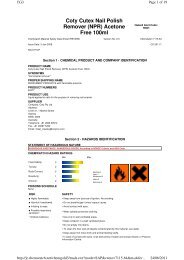Diversey Divermite D10 - ACT Health Supply Services
Diversey Divermite D10 - ACT Health Supply Services
Diversey Divermite D10 - ACT Health Supply Services
You also want an ePaper? Increase the reach of your titles
YUMPU automatically turns print PDFs into web optimized ePapers that Google loves.
CG3<br />
Intraperitoneal (Rat) LD50: 67 mg/kg<br />
Oral (Rat) LD50: 1720 mg/kg<br />
Intraperitoneal (Mouse) LD50: 50 mg/kg<br />
Oral (Guinea pig) LD50: 620 mg/kg<br />
Subcutaneous (Rat) LD50: 1500 mg/kg<br />
Intravenous (Rat) LD50: 225 mg/kg<br />
<strong>Diversey</strong> <strong>Divermite</strong> <strong>D10</strong><br />
Oral (Mouse) LD50: 700 mg/kg<br />
■ The material may cause skin irritation after prolonged or repeated exposure and may produce on contact skin redness, swelling,<br />
the production of vesicles, scaling and thickening of the skin.<br />
Asthma-like symptoms may continue for months or even years after exposure to the material ceases. This may be due to a nonallergenic<br />
condition known as reactive airways dysfunction syndrome (RADS) which can occur following exposure to high levels of<br />
highly irritating compound. Key criteria for the diagnosis of RADS include the absence of preceding respiratory disease, in a nonatopic<br />
individual, with abrupt onset of persistent asthma-like symptoms within minutes to hours of a documented exposure to the<br />
irritant. A reversible airflow pattern, on spirometry, with the presence of moderate to severe bronchial hyperreactivity on<br />
methacholine challenge testing and the lack of minimal lymphocytic inflammation, without eosinophilia, have also been included in<br />
the criteria for diagnosis of RADS. RADS (or asthma) following an irritating inhalation is an infrequent disorder with rates related to<br />
the concentration of and duration of exposure to the irritating substance. Industrial bronchitis, on the other hand, is a disorder that<br />
occurs as result of exposure due to high concentrations of irritating substance (often particulate in nature) and is completely<br />
reversible after exposure ceases. The disorder is characterised by dyspnea, cough and mucus production.<br />
* Bayer<br />
WATER:<br />
■ No significant acute toxicological data identified in literature search.<br />
Section 12 - ECOLOGICAL INFORMATION<br />
Hazard Alert Code:<br />
HIGH<br />
Chemwatch Material Safety Data Sheet (REVIEW) Version No: 2.0 Chemwatch 4537-95<br />
Issue Date: 29-Jan-2010 CD 2011/1<br />
NC317TCP<br />
Page 8 of 10<br />
MONOETHANOLAMINE:<br />
■ for monoethanolamine:<br />
log Kow : -1.31<br />
Koc : 5<br />
Half-life (hr) air : 11<br />
Henry's atm m3 /mol: 4.00E-08<br />
BOD 5: 0.8-1.1,0%<br />
Biodegradability:<br />
BOD5: 800 mg/g<br />
>70%: BOD of the ThOD (OECD 301F)<br />
>90%: DOC reduction (OECD 301A)<br />
COD : 1.27-1.28<br />
ThOD : 2.49<br />
BCF : 70%* (OECD 301F)<br />
Biodegradation under aerobic static laboratory conditions is high (BOD20 or BOD28/ThOD >40%)<br />
BOD20 (Biochemical Oxygen Demand after 20 days): 1.5 p/p<br />
ThOD (Theoretical Oxygen Demand)): 2.36 p/p (calc).<br />
IC50 (Inhibitory Concentration): >1000 mg/l<br />
Biodegradation: Test method: OECD 301F; ISO 9408; 92/69/EEC, C.4-D (aerobic), activated sludge, domestic<br />
Degree of elimination: 90 - 100 % (28 d)<br />
Evaluation: Readily biodegradable (according to OECD criteria).<br />
This material will biodegrade relatively rapidly in both soil and water, and will not persist in the environment.<br />
Monoethanolamine is biodegraded or transformed into other compounds under both aerobic and anaerobic conditions even at<br />
concentrations greater than 1500 mg/kg. Ammonium, acetate, and nitrogen gas are the dominant by-products . The generation of<br />
nitrogen gas suggests that simultaneous nitrification and denitrification occurs because of the existence of anoxic zones resulting<br />
from diffusion limited oxygen transport into the soils.Low temperatures (5 C) reduced the biodegradation rates significantly<br />
compared to rates at room temperature.<br />
Bioaccumulation: Because of the n-octanol/water distribution coefficient (log Pow) accumulation in organisms is not to be expected.<br />
Bioconcentration potential is low (BCF less than 100 or log Kow less than 3).<br />
Bioaccumulation: Because of this material's high solubility and rapid biodegradability, it is unlikely that bioaccumulation will<br />
occur in aquatic or terrestrial systems.<br />
Biochemical oxygen demand (BOD): Incubation period 5 d: 800 mg/g<br />
Due to the pH-value of the product, neutralization is generally required before discharging sewage into treatment plants.<br />
Ecotoxicity:<br />
This material is highly soluble in water. Laboratory toxicity tests indicate that is not significantly toxic to fish and aquatic<br />
http://jr.chemwatch.net/chemgold3/msds.exe?mode=SAP&cwno=4537-95&msdsfor...<br />
24/06/2011



